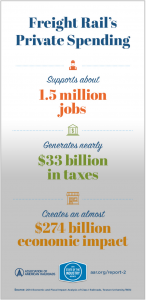Alexandria, VA – For every dollar freight railroads spend on building, maintaining and enhancing America’s 140,000-mile rail network, $10 is generated in economic impact, according to a new study from Towson University’s Regional Economic Studies Institute (RESI). Freight rail investments also support 1.5 million jobs across the country—nine jobs for every rail job.
 The study, for the first time ever, quantifies the economic impact of freight railroads’ private investments, which surpass $600 billion since 1980 and are expected to reach $26 billion in 2016. In a State of the Industry report released along with the new research, the Association of American Railroads (AAR) says that the findings demonstrate freight rail’s “powerful economic ripple effect across a myriad of U.S. industries.”
The study, for the first time ever, quantifies the economic impact of freight railroads’ private investments, which surpass $600 billion since 1980 and are expected to reach $26 billion in 2016. In a State of the Industry report released along with the new research, the Association of American Railroads (AAR) says that the findings demonstrate freight rail’s “powerful economic ripple effect across a myriad of U.S. industries.”
“Whether selling and building automobiles and houses, powering businesses or enabling manufacturers to reach new customers, American industries rely on rail to get raw goods and products to market in the United States and beyond,” writes Ed Hamberger, AAR CEO and President. “The net economic effect is profound.”
In 2014, the year that was examined in the study, spending by Class I railroads created $274 billion in economic activity and generated nearly $33 billion in total tax revenues. Of these taxes, $11.9 billion were collected at the local and state levels, exceeding the tax revenues collected by 30 states.
The study links the success of this powerful economic engine to the Staggers Rail Act of 1980, which created a balanced regulatory framework that allowed railroads to run like businesses and earn enough capital to invest back into their network.
Researchers pointed to the impact of these private investments for customers, noting that rail productivity has increased 139 percent since the Staggers Act. “Most of these productivity gains were passed through to rail customers—decreasing the cost of utilizing rail transportation,” says the report.
Learn more about freight rail’s economic impact in your community and read the study: https://www.aar.org/report2.


